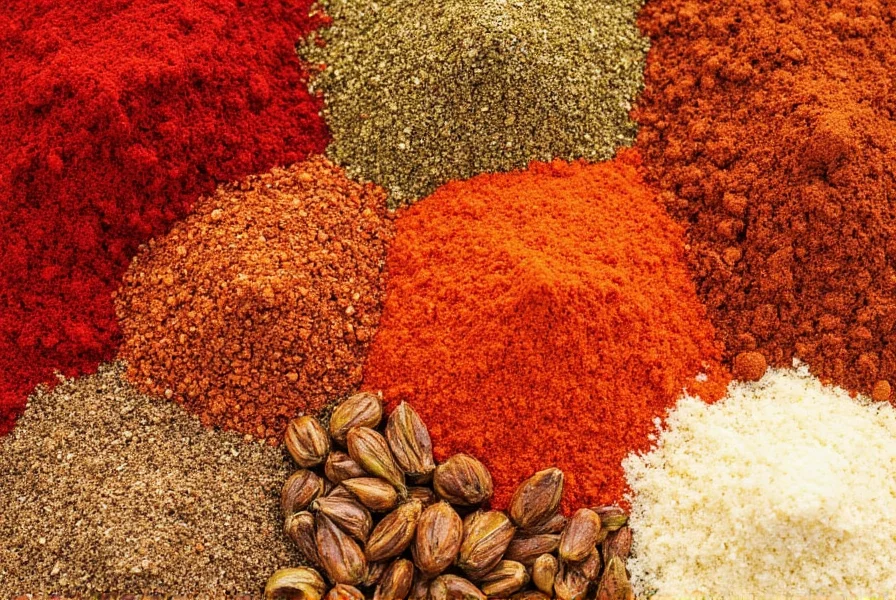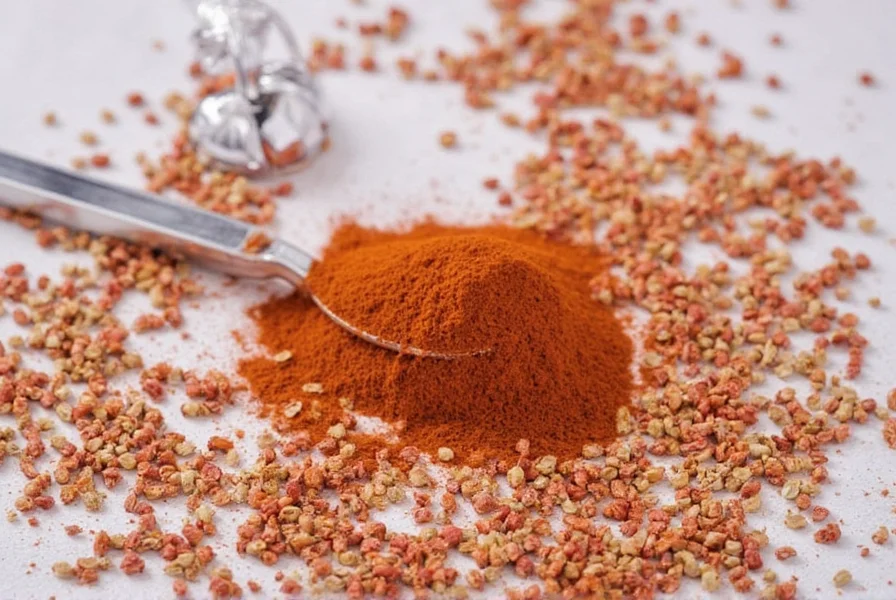Table of Contents
Introduction to Ground Red Chili Pepper
Ground red chili pepper, also known as cayenne pepper or red pepper flakes, is a versatile spice made from dried red chilies ground into powder. It's not just for adding heat to dishes; it also offers numerous health benefits, including boosting metabolism and reducing inflammation. In this guide, we'll cover everything you need to know about ground red chili pepper, from its health benefits to expert cooking tips and how to choose the best quality.
According to a study published in the Journal of Medicinal Food, capsaicin—the compound responsible for the heat in chili peppers—has been shown to increase metabolism by up to 5% and may help with weight management. Additionally, the American Heart Association notes that capsaicin may help reduce blood pressure and improve circulation. These scientific findings confirm why ground red chili pepper is more than just a kitchen staple—it's a functional ingredient with real health benefits.
Health Benefits of Ground Red Chili Pepper
Ground red chili pepper offers several scientifically-backed health benefits:
- Boosts Metabolism: Capsaicin increases thermogenesis, helping your body burn calories faster. Research shows it can raise metabolic rate by up to 5% for several hours after consumption.
- Reduces Inflammation: Capsaicin has anti-inflammatory properties that may help with conditions like arthritis and joint pain.
- Supports Heart Health: Studies indicate capsaicin can help lower blood pressure and improve cholesterol levels.
- Enhances Digestion: It stimulates digestive enzymes and can help relieve indigestion and stomach discomfort.
- Rich in Vitamins: High in vitamin A (for vision and immune health) and vitamin C (an antioxidant that supports skin health).
For maximum benefits, use ground red chili pepper consistently as part of a balanced diet. However, those with sensitive stomachs or certain medical conditions should consult a healthcare provider before regular consumption.
Practical Tips for Using Ground Red Chili Pepper
Here are expert tips to get the most out of ground red chili pepper in your cooking:
- Start Small: Begin with 1/8 teaspoon for dishes serving 4 people. You can always add more, but you can't remove it once added.
- Pair with Complementary Flavors: Combine with cumin, garlic, or smoked paprika to balance heat and create complex flavors. For sweet applications, mix with honey or brown sugar to offset spiciness.
- Use in the Right Dishes: It works best in recipes where heat enhances flavor, such as chili con carne, curries, roasted vegetables, and even hot chocolate.
- Store Properly: Keep in an airtight container away from light and moisture. Properly stored, it maintains potency for 6-12 months.
- Test Before Adding: When cooking for others, prepare a small taste test batch before adding to the main dish.
Buying Guide: How to Choose the Best Ground Red Chili Pepper
| Feature | What to Look For |
|---|---|
| Origin | Look for high-quality chilies from regions known for their spiciness, like Mexico (for cayenne) or India (for Kashmiri red chili). |
| Heat Level | Check the Scoville scale rating: Mild (500-2,500 SHU), Medium (2,500-30,000 SHU), Hot (30,000-100,000 SHU), Extra Hot (100,000+ SHU). |
| Texture | It should be fine and powdery, not clumpy or gritty. Shake the container—good quality should flow smoothly. |
| Ingredients | Choose pure ground red chili pepper without additives or fillers. Look for "100% red chili" on the label. |
| Brand Reputation | Opt for reputable spice brands like McCormick, Frontier Co-op, or Penzeys, which have rigorous quality control standards. |
| Color | Vibrant red color indicates freshness. Dull brownish-red means it's past its prime. |

When shopping, check the expiration date and avoid bulk bins where moisture exposure can degrade quality. For the best flavor and heat, buy small quantities and use within 6 months.
Cooking with Ground Red Chili Pepper: Recipes and Techniques
Ground red chili pepper is incredibly versatile. Here are expert-approved ways to use it:
- Spicy Tomato Sauce: Add 1 teaspoon to 2 cups of crushed tomatoes with garlic and olive oil. Simmer for 15-20 minutes for a rich, flavorful pasta sauce.
- Chili Con Carne: Use 1.5 teaspoons per pound of meat for authentic Tex-Mex flavor. Combine with cumin, oregano, and smoked paprika for depth.
- Roasted Vegetables: Toss vegetables with olive oil, salt, and 1/2 teaspoon ground red chili pepper per cup of veggies before roasting for a smoky kick.
- Hot Chocolate: Add a pinch (1/16 teaspoon) to hot chocolate for a warming, spicy twist that complements chocolate's richness.
- Marinades: Mix 1 teaspoon with 2 tablespoons olive oil, 1 minced garlic clove, and herbs for a spicy chicken or tofu marinade.
- Spice Rubs: Combine with brown sugar, salt, and smoked paprika for a sweet-and-spicy rub for ribs or grilled meats.
Pro Tip: For even heat distribution, mix ground red chili pepper with a small amount of oil before adding to dishes. This helps release its flavor compounds more effectively.
Conclusion
Ground red chili pepper is far more than just a spice—it's a scientifically-backed ingredient with real health benefits and culinary versatility. By understanding its heat levels, health properties, and proper usage techniques, you can transform ordinary dishes into extraordinary meals. Whether you're looking to boost metabolism, enhance flavor, or simply add some excitement to your cooking, ground red chili pepper is an essential tool in any kitchen.
Remember: Start small, store properly, and experiment with confidence. With these expert tips, you'll master the art of using ground red chili pepper like a professional chef.
Frequently Asked Questions
Can ground red chili pepper help with weight loss?
Yes, studies show capsaicin in chili peppers can boost metabolism by up to 5% and increase fat burning. According to research in the Journal of Nutritional Science, regular consumption may help reduce appetite and calorie intake. However, it should be part of a balanced diet and exercise routine for best results.
How much ground red chili pepper should I use for weight loss?
For weight management, aim for 1/4 to 1/2 teaspoon daily. Start with smaller amounts (1/8 teaspoon) and gradually increase. Consistency is key—incorporate it into meals regularly rather than consuming large amounts at once.
What's the difference between ground red chili pepper and chili powder?
Ground red chili pepper is made purely from dried red chilies, while chili powder typically contains a blend of spices including garlic powder, cumin, and oregano. Ground red chili pepper delivers more intense heat (Scoville 30,000-100,000 SHU), whereas chili powder provides a more complex flavor profile with moderate heat (Scoville 1,000-5,000 SHU).
Can ground red chili pepper improve skin health?
Yes, ground red chili pepper is rich in vitamin A (for cell growth and repair) and vitamin C (a powerful antioxidant). These nutrients help protect skin from damage and promote collagen production. However, excessive consumption may cause digestive issues, so moderation is important.
How long does ground red chili pepper stay fresh?
Properly stored in an airtight container away from light and moisture, ground red chili pepper maintains its potency for 6-12 months. After that, it won't spoil but will gradually lose its heat and flavor. You'll know it's past its prime when the vibrant red color fades to a dull brownish-red.
What should I do if I've added too much ground red chili pepper to my dish?
If your dish becomes too spicy, try adding dairy (like yogurt or cream), acid (lemon juice or vinegar), sweetness (sugar or honey), or more of the other ingredients to dilute the heat. Serving with rice, bread, or potatoes can also help absorb some of the spiciness when eating.
Is ground red chili pepper safe for people with acid reflux?
Ground red chili pepper may trigger acid reflux symptoms in some individuals due to its heat. If you have GERD or acid reflux, it's best to avoid or limit consumption. Consult your doctor before using it regularly if you have digestive issues.
Can I substitute ground red chili pepper for fresh chilies in recipes?
Yes, but with caution. As a general rule, 1/2 teaspoon of ground red chili pepper equals about one medium fresh chili. Remember that ground pepper delivers more concentrated heat, so you may want to use slightly less than the conversion suggests, especially with hotter varieties.
Does ground red chili pepper have any side effects?
When consumed in moderation, ground red chili pepper is generally safe. However, excessive consumption may cause digestive discomfort, heartburn, or stomach irritation. Those with sensitive stomachs, ulcers, or certain medical conditions should consult a healthcare provider before regular use.











 浙公网安备
33010002000092号
浙公网安备
33010002000092号 浙B2-20120091-4
浙B2-20120091-4